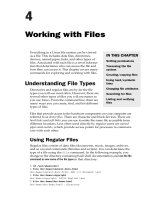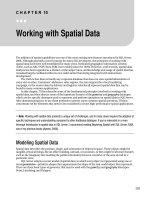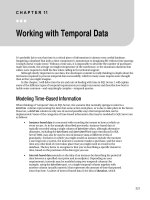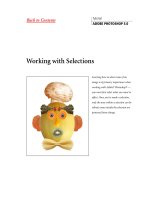Working with gouache pptx
Bạn đang xem bản rút gọn của tài liệu. Xem và tải ngay bản đầy đủ của tài liệu tại đây (168.46 KB, 9 trang )
Working with gouache
Working With Gouache - Opaque watercolor
"Where Man Is A Probable Stranger" ©
Gouache Opaque Watercolor
I want to state that I don't claim to be an expert on gouache. All I know is,
the first time I put Gouache down on watercolor paper, it was love at first
sight.
I hope that by showing you a few examples of how I work with gouache,
you'll have a better understanding about the medium. Who knows, it may
encourage you to try Gouache for yourself!
Gouache demonstration
The Photograph ©
Courtesy of Maury
Kettell.
Drawing
I drew my composition
directly onto 140lb
Lanaquarelle 9" x 12”
watercolor paper. I stayed
pretty true to the
photograph but added the
fallen log for additional
Beginning
I chose a Blue-Purple as
my dominant hue with
Cadmium Yellow-Orange
as the complimentary
color. Cobalt Blue and
Violet are the adjacent
hues to the Blue-Purple
interest.
with Yellow-green and
Yellow-Orange as the two
discord colors. I went
back and refined my
drawing by adding a few
more rocks for interest.
Midway
This is where the fun part
begins. I usually pick one
main element in my
painting, and connect
everything else to it. At
this point I have a pretty
Nearing Completion
Working the painting as a
whole, checking to see
where improvements can
be made. Painting and
refining the water was
very enjoyable and
Finish
I added some additional
dark areas back in the
foreground rocks. I got
carried away with flinging
paint, both dark and light.
good idea where I'm going
with the painting. Now
it's just a matter of
working the painting as a
whole.
relaxing. I had to keep in
mind that the rocks both
above and below the
water line will influence
the color of the water.
I did enjoy the process.
What is gouache ?
It simply is pigments in a gum-based solution,
capable of rendering beautiful works of art.
Gouache (gwaash) tends by it's nature to dry to
a rich vivid opaque color and is a favorite of
illustrators. Unlike watercolor, gouache
doesn't rely on the whiteness of the support
you're painting on to show brilliance. Gouache
lays right on the surface and isn't used as a
stain like most watercolor pigment.
Gouache is
thinned with plain old water, the same as
watercolor, acrylic, and casein.
Getting started
Winsor & Newton Designers Gouache, and Da
Vinci Gouache are the two that I use. I started
with Winsor & Newton
and have recently been
working with Da Vinci. For the demonstration
on this page I used; Da Vinci Gouache and
found it pleasing to work with. I recommend
either one as each has excellent qualities.
Supplies
Brushes: Sable and artificial sable brushes work best. (Your choice of size
and shape)
Surface: Illustration board cold or hot-press and watercolor paper 140lb or
300lb cold or hot- press. (Your choice of brand)
Paints: Winsor & Newton Designers Gouache or Da Vinci Gouache. If
you like working with a specific brand of watercolor, check to see if they
also carry it in Gouache. It is not necessary to invest your hard earned artist
dollars in 10 tubes of gouache you may only use once. Try this, just buy
only 4 tubes: Permanent White, Cadmium Yellow Lt., Cadmium Red Lt.,
Ultramarine Blue. Use your yellow and red to make orange, your red and
blue to make violet and your yellow and blue to make your green.
Palette: Any covered watercolor type palette or butcher's tray (cover
butcher's tray with plastic wrap when not in use).
My palette colors
Limited PaletteColors: Permanent White, Cadmium Yellow Lt., Cadmium
Orange, Cadmium Red Lt., Alizarin Crimson, Violet, Cobalt Blue,
Ultramarine Blue, Phthalo Green, Sap Green. This is the order in which I
place the colors on my palette.
A few comments about my choice of palette colors, and how I work with
them. As you can see I try not to use tube earth colors on my palette. In my
opinion, by mixing your own earth colors from the primaries, your colors
will be richer and more vibrant. I can't stress enough how important it is for
a beginning painter to work with a limited palette. When I first started
painting with oils, I thought that I had to have every color on the planet. All
I got from that way of thinking was frustration with dull, muddy colors.
Now in defense of mud, it is possible to gain some beautiful grays/neutrals.
Only when your painting is totally muddy, does all life go out of it. A
limited palette when traveling is also a real plus for an artist.
Tip: Keep a spritzer bottle filled with water to keep your gouache paints
moist. I keep a small wet sponge inside my gouache palette when I'm not
working with it. Change your water container often. You might want to try
using two water containers.
I hope this demonstration has served to give you an understanding of how I
work with Gouache.
Suggested Reading
Pamela Kay "A Personal View
Stephen Quiller and Barbara Whipple
Gouache" Publisher David &
Charles ISBN 0 7153 0289 2
"Water Media: Processes And
Possibilities" Publisher Watson-Guptill
ISBN 0 8230 5695 3
Gouache for Illustration Rob Howard "Gouache For Illustration" Publisher
Watson-Guptill ISBN 0 8230 2165 3
Ned Mueller to my knowledge has yet to write a book on gouache. He has
written several articles about gouache in various publications of Artist
Magazine. Ned Mueller is the artist most responsible for my interest in
working with gouache.









